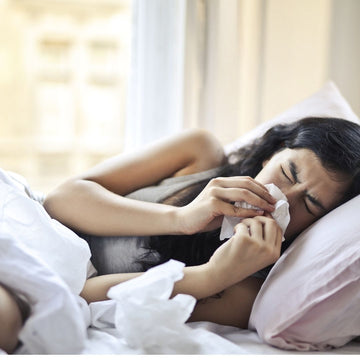When people think of allergies, they often imagine pollen-filled gardens or dusty storage rooms. But the truth is far scarier: your bed may be the single biggest allergen factory in your home.
Every night, you spend 6–8 hours breathing in microscopic particles that can trigger sneezing, blocked noses, eczema flare-ups, and even asthma.
Let’s break it down scientifically
1. Dust Mites – The Invisible Residents in Your Sheets
Dust mites thrive in warm, humid environments — and your bed is their paradise. They feed on dead skin cells, producing waste particles that are potent allergens.
-
Studies show that a single gram of dust can contain up to 1,000 dust mites.
-
Their droppings contain proteins that trigger allergic reactions, especially in people with sensitive skin or asthma.
Solution: Washing sheets at 60°C has been proven to kill dust mites, but fabric choice also matters. Breathable, tightly woven cotton reduces mite colonization compared to synthetic fabrics.
(Related read: Why Your Bedding Must Be Oeko-Tex® Certified)
2. Mold & Humidity – Why Your Sheets Might Smell Musty
Moisture is another allergen trap. Sweat and humidity create the perfect breeding ground for mold spores.
-
Mold spores are microscopic but highly inflammatory when inhaled.
-
Research links bedroom mold to chronic sinus problems, night-time coughing, and even poor sleep quality.
Solution: Use fabrics that wick moisture instead of trapping it. Egyptian cotton, for example, is naturally breathable and helps regulate humidity in bedding.
3. Chemical Allergens in Textiles – Formaldehyde & VOCs
It’s not just dust and mold. Many cheaper textiles are treated with formaldehyde resins, dyes, and volatile organic compounds (VOCs).
-
These chemicals can cause skin irritation, rashes, and worsen eczema.
-
The WHO classifies formaldehyde as a carcinogen, making long-term exposure risky.
This is why OEKO-TEX® certification matters — it ensures your bedding is free from harmful substances.
4. Science-Backed Tips to Reduce Bedroom Allergens
-
Wash bedding weekly at 60°C.
-
Vacuum your mattress with a HEPA filter every 2–3 weeks.
-
Use tightly woven cotton sheets to block allergen penetration.
-
Avoid scented detergents — many contain skin irritants.
-
Replace bedding every 1–2 years if it shows signs of wear or persistent odor.
5. Final Word – Your Bed Should Heal You, Not Harm You
Science is clear: bedding is not just about comfort — it’s your frontline defense against allergens. The fabric you sleep on directly impacts your skin health, respiratory system, and sleep quality.
If you’re struggling with allergies or skin flare-ups, your bedroom might be the first place to start making changes.






